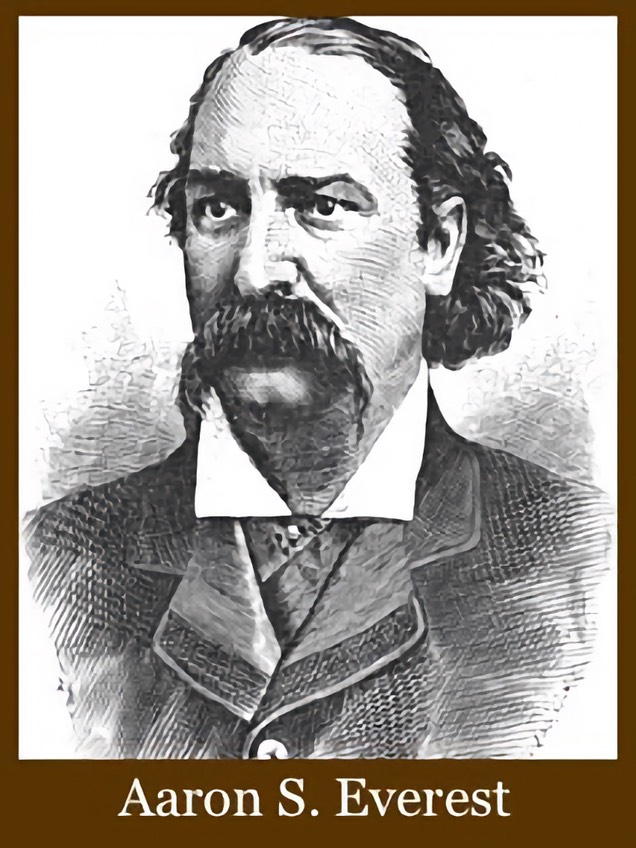An investigation into the 1893 failure of the State Exchange Bank in Courtland, Kansas, and its sibling bank in nearby Jamestown, determined that they were not failures at all, but brilliant successes, engineered by their founder, Col. Aaron S. Everest of Atchison. Careful audits of both institutions came to the conclusion that banking in the small north-central Kansas towns had been conducted with the exclusive aim of enriching the Everest family and no one else.
Emerging from the Civil War with the brevet rank of Lieutenant Colonel of Volunteers, Everest opened a law office in Austin, Minnesota, apparently specializing in mortgage law, judging from the frequent appearance of his name in foreclosure notices. An 1870 issue of a local newspaper contains a single mention of Everest's recent arrest on the charge of seducing 19-year-old Emma Chandler. Everest was a Democrat, thus it was the business of a rival Republican paper to devote typespace to the juicy details. While the outcome of the seduction case remains unclear, 1870 happens to be the same year Aaron S. Everest pulled up stakes in Austin and hung out his shingle in Atchison, Kansas.

He prospered there, serving as attorney for the Central Branch, Union Pacific Railroad, and a member of the Kansas Senate where he represented Atchison County and, by most accounts, railroad interests. Having invested heavily in local real estate, it was when the real estate market and railroad-building simultaneously stalled that he turned his hand to banking in 1889.
Investing $5,000 in capital stock, the absolute minimum, into each bank, Everest kept his own risk low. Visiting his banks with an empty valise just before they were shuttered four years later, he would then retire to Atchison to dash off a flurry of I.O.U.’s to family members, before climbing into his sickbed, which became his deathbed the following year.
Thomas Lovewell personally lost $1,200 in the bank failure, equivalent to more than ten times that amount today. Coming near the start of an economic depression would have further magnified the loss. He sued Aaron Everest not only for himself, but on behalf of one of his sons and several townspeople at Lovewell, as well as the M.E. Church, hoping to recover a percentage of the value of their emptied accounts.
After Colonel Everest died, Lovewell sued the widow who was executrix of her husband’s estate. However, he would have to stand in line. The Everests were already suing each other. They were good at it.
Belle Everest, the estranged wife of Aaron Everest’s only son Frank, reconciled with her husband in an effort to break the will on Frank’s behalf, claiming that he had been his father’s business partner right up to the end. Frank, formerly an officer in the Everest banks, but lately a morphine addict, received no mention at all in the will and would die four years later.
Frank Everest was glowingly recalled by the citizens of Courtland and Jamestown for his affable nature and his comedic wit. He was a man who should have pursued a career on the stage, they said.
An Everest heir who was lovingly singled out for a share of the estate and a commemorative keepsake, was Aaron Everest’s granddaughter and adopted daughter, Marie Fleming Everest. Marie was the product of the marriage of Aaron Everest’s daughter Kittie Clover Everest to a wealthy Philadelphian named William Thomas Fleming.
After their divorce Kittie walked away with a neat slice of her husband’s money, and over a million dollars more apparently fell to her daughter when Mr. Fleming died a few years afterward. By the time of Fleming’s death in 1899, Kittie had remarried - twice. A hasty marriage to a traveling salesman was quickly brushed aside and the bride was restored to her maiden name in time to marry H. L. Magee, an official with the Wabash Railway.
The pattern of aggrandizement through matrimony would be repeated by Kitty’s daughter Marie. An exceptionally beautiful young woman, Marie Fleming Everest would be a favorite of portrait painters and older men with large fortunes.
To be fair, the men were not that much older and the fortunes were not Fleming-sized, even before being whittled down by sometimes-scandalous divorce proceedings or untimely deaths.
During one of Marie’s later tussles over a former-husband’s estate, newspapers seemed to relish underlining her complicated career by repeatedly referring to the young woman as “Marie Fleming Everest Brown-Eastes.” The “Everest” part was not even her fault.
The lawyers whom Thomas Lovewell could afford would never succeed in prying thousands of dollars out of the clutches of the Everest family. Thomas must have realized that he was playing out of his league. He would have a greater chance of success by sifting the beach at Nome, Alaska, for overlooked flecks of gold, or digging holes in the earth of southeastern Wyoming searching for precious nuggets. So he tried those things instead.
This page is illustrated with the same old engraving of a pencil drawing of Aaron S. Everest that I always use. I’ve long wondered why there seem to be no photographs of the Civil War hero and politician, and may have run across the answer by accident.
An editor once mused about the absence of his portrait among a collection of prominent attorneys, confiding that “Aaron S. Everest, the senior member of the firm, has a horror of photographs, so we are denied the pleasure of seeing his familiar countenance.”
He probably much preferred the glorified rendering of a man in his prime, with flowing Byronic locks and formidable mustache. It was every bit the match for the mustache worn by Custer making his last stand in barroom lithographs across America.
Everest made his last stand lying down with a pen in his hand, only hours before he died.